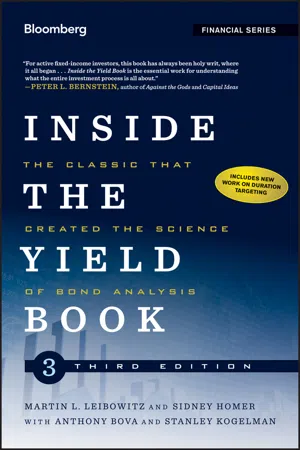
Inside the Yield Book
The Classic That Created the Science of Bond Analysis
- English
- ePUB (mobile friendly)
- Available on iOS & Android
Inside the Yield Book
The Classic That Created the Science of Bond Analysis
About this book
A completely updated edition of the guide to modern bond analysis
First published in 1972, Inside the Yield Book revolutionized the fixed-income industry and forever altered the way investors looked at bonds. Over forty years later, it remains a standard primer and reference among market professionals. Generations of practitioners, investors, and students have relied on its lucid explanations, and readers needing to delve more deeply have found its explication of key mathematical relationships to be unmatched in clarity and ease of application.
This edition updates the widely respected classic with new material from Martin L. Leibowitz. Along the way, it skillfully explains and makes sense of essential mathematical relationships that are basic to an understanding of bonds, annuities, and loans—in fact, any securities or investments that involve compound interest and the determination of present value for future cash flows. The book also includes a new foreword.
- Contains information that is more instructive, important, and useful than ever for mastering the crucial concepts of time, value, and return
- Combines the clear fixed-income insights found in the original edition with completely new knowledge to help you navigate today's dynamic market
- Includes over one hundred pages of new material on the role of bonds within the total portfolio
In an era of calculators and computers, some of the important underlying principles covered here are not always grasped thoroughly by market participants. Investors, traders, and analysts who want to sharpen their ability to recall and apply these fundamentals will find Inside the Yield Book the perfect resource.
Frequently asked questions
- Essential is ideal for learners and professionals who enjoy exploring a wide range of subjects. Access the Essential Library with 800,000+ trusted titles and best-sellers across business, personal growth, and the humanities. Includes unlimited reading time and Standard Read Aloud voice.
- Complete: Perfect for advanced learners and researchers needing full, unrestricted access. Unlock 1.4M+ books across hundreds of subjects, including academic and specialized titles. The Complete Plan also includes advanced features like Premium Read Aloud and Research Assistant.
Please note we cannot support devices running on iOS 13 and Android 7 or earlier. Learn more about using the app.
Information
Part I
Duration Targeting: A New Look at Bond Portfolios (2013 Edition)
Accrual Offsets of Price Effects
Trendline Model
The Effective Maturity
Terminal Yield Distributions
Non-Trendline Paths
Table of contents
- Cover
- Contents
- Title
- Copyright
- Dedication
- Preface to the 2013 Edition
- Acknowledgments
- Part I: Duration Targeting: A New Look at Bond Portfolios (2013 Edition)
- Part II: Some Topics That Didn’t Make it into the 1972 Edition (2004 Edition)
- Part III: Inside the Yield Book (Original Edition)
- About the Authors
- Index